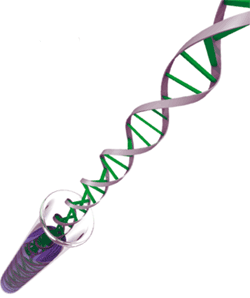



Demonstration Studies in Dairy Cattle: Genomic Selection
The final scientific report from the EU group, Sustainable Animal Breeding (SABRE), subtitled 'Cutting Edge Genomics for Sustainable Animal Breeding', explains how genomic selection could be used in practice in two dairy cattle populations.
Genomic tools resulted in a novel method of selection called “genomic selection” in which dense SNP genotypes covering the entire genome are used to predict the genetic value of an animal. In this project we demonstrated that genomic selection could be used in practice in two dairy cattle populations.
Why genomic selection?
Genomic selection eliminates the need for trait recording of all elite breeding animals, which is especially helpful when selecting for functional traits. Those traits are often difficult or impossible to measure in elite animals, such as disease resistance (requires disease challenge), female fertility (cannot be recorded on elite males), and longevity (record comes too late). Instead of recording traits on many animals, both a large reference population with many recorded tratis and information of the genome are required before genomic selection schemes can be applied.
The efficiency of high-throughput methods for SNP marker genotyping, the so called SNP chip genotyping, has increased dramatically since 2006. This resulted in the development of cost effective use of SNP chips with about 50,000 SNPs for cattle, pigs, sheep, dogs, and horses. For cattle a high-density SNP chip was developed in 2010 with 700,000 SNPs. All these SNPs are quite affordably priced so that many animals can be genotyped, resulting in massive amounts of marker genotyping data.

Research to use massive amounts of SNP data
The ultimate goal of genomics in breeding is to predict function and performance in individuals from molecular genetic tools. The demonstration studies in SABRE aim at showing how far we have progressed towards achieving this ultimate goal.
Methods to use
There are two methods of use:
- The gene mapping approach: through their association with genes, the markers are used to detect genes and identify the causative mutation. Aft er that the positive allele is increased by selection.
- Genomic selection: we select directly for the SNPs with positive effects and the genetic value of the animals is improved through their association with genes. This approach does not test whether a SNP is associated with a gene, but uses all SNPs simultaneously.
In case of complex traits with many genes and the environment affecting the trait, the gene mapping approach is ineffective because there are too many genes to map and the effect of every gene is too small to detect or map precisely. Thus, our aim was to demonstrate that genomic selection could achieve accurate predictions of genetic values for complex livestock production traits.
Genomic selection in action
The use of genomic selection consist of three steps:
- Part of the population is genotyped using the dense SNP chip and phenotyped for complex traits. This is referred to as the so-called reference population.
- The effect of all the SNPs is estimated in the reference population by statistical models; where the association between SNPs and phenotypes is calculated, resulting in the prediction equations.
- Another part of the population is genotyped using the same SNP chip and the total genetic value of the animals is predicted by using the prediction equations derived from step 2.
Genomic selection was demonstrated in practice in two dairy cattle populations in this project. For this, 500 Norwegian Red Cattle bulls and 230 Holstein bulls were genotyped and phenotyped for milk production, mastitis and fertility traits. Accuracies of estimated genetic values ranged from 0.2 to 0.6, where the higher accuracies occurred for traits with higher heritability. In view of the small population sizes, the achieved accuracies are considered very promising, at least for the production traits.
January 2012


